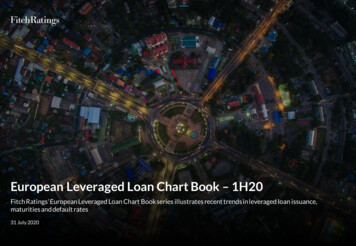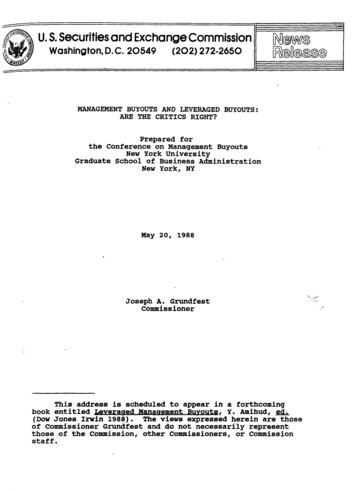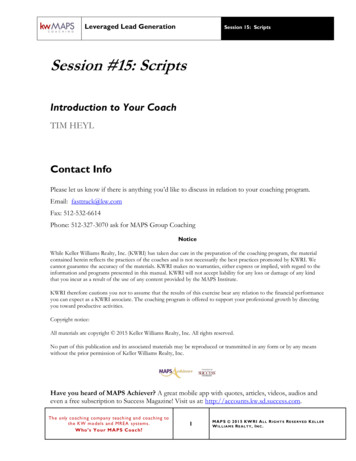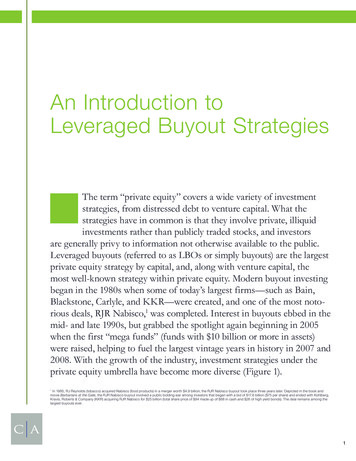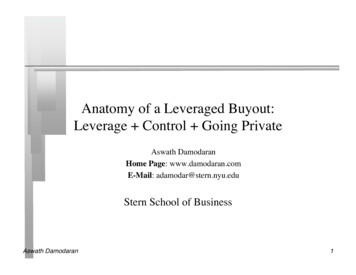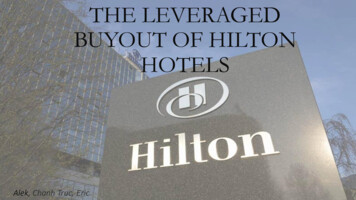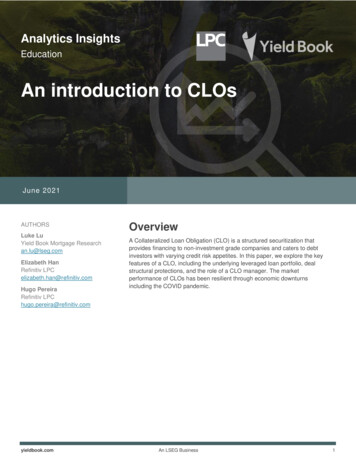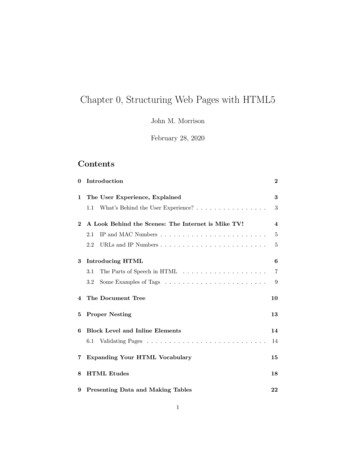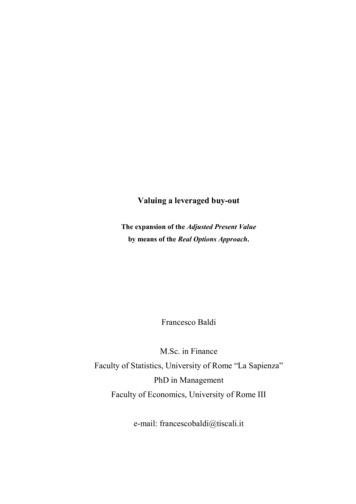
Transcription
Valuing a leveraged buy-outThe expansion of the Adjusted Present Valueby means of the Real Options Approach.Francesco BaldiM.Sc. in FinanceFaculty of Statistics, University of Rome “La Sapienza”PhD in ManagementFaculty of Economics, University of Rome IIIe-mail: francescobaldi@tiscali.it
1. IntroductionThe expression leveraged buy-out (LBO) means a financial technique thatconsists in the acquisition of the majority stake of a firm by a group of buyersendowed with entrepreneurship, composed of private investors or institutionalinvestors or merchant banks or by all three subjects together, that is mostlyfinanced by debt, destined to be paid back by using the financial resourcesproduced by the firm itself in the form of operating cash flows or divestments ofnon-strategic activities, as well as assets and shares as side guarantee to obtainthe loan.The fundamental characteristic of a leveraged buy-out is given by the factthat the acquiring of the shares or assets of the so-called target firm or of asubsidiary or of a part of it, is effected by utilizing a significant amount of debtand a very low quantity of equity capital. Then, in a wider meaning, a leveragedbuy-out may be also defined as every acquisition that leaves the acquired firmwith a leverage ratio higher than it was before the acquisition.The main economic principle the leveraged buy-out technique relies on isthe exploitation of a capital market inefficiency: the presence of taxation.According to the Modigliani-Miller’s intuition, if there was not taxation in theeconomy the choice of a given financial structure for a firm would have anindifference effect on its value. Taxes, instead, contribute to the imperfection ofthe valuation mechanism in use in the financial markets, as an unlevered and alevered firm are differently valued. Taxes perform a specific role in theeconomy of a firm that consists of making interests related to debt act as a shieldtowards operating profits to be destined to tax payment. The fiscal deductibilityof financial interests expands the Free Cash Flows from Operations bypreventing a part of them from being paid out and that allows for an increase ofthe firm value. Such a capital market inefficiency produces a misalignment in2
the risk perception between debt and equity market in the sense that bondholdersattribute a lower degree of riskiness to the firm if levered than equity investorsdo as to the same one if totally unlevered. Such a misalignment may beexploited by turning to a greater portion of debt instead of equity in order toincrease the overall value of the firm.The goal of a leveraged buy-out can be of a dual nature: a strategicindustrial nature and a financial-speculative nature.In the first case, the potential buyers look at the industrial features of thedeal and rely on their capacity of improving the static and the dynamicefficiency of the management of the core-business, namely the technical way ofperforming production operations and the capability of adapting to changingexternal conditions such as market conditions, in order to enhance the targetfirm’s profitability. Besides the growth of operating profits, a fixed capitalreduction is also performed by means of a non-core assets divestment process(asset stripping) and/or a lease-back process so that the ROI of the target firm isimproved. Such a beneficial improvement should favour value creation, if thedifference between the ROI and the cost of debt is positive and hence, generateextra Free Cash Flows from Operations in order to pay interests related to thegreater amount of debt contracted. Additionally, the resort to debt cancomplement the enhanced operating cash flows with the further cash trap that isbased on the fiscal deductibility of financial interests (leverage effect). Theevidence of such a cash trapping mechanism is the gradual increase of the netincome component of the target firm’s ROE.The structuring of a leveraged buy-out can also be merely motivated bythe attainment of a financial-speculative objective. In this case, the expediencyof the deal derives from the chance of taking advantage of another form ofcapital market inefficiency which is not properly exploited and, once again, liesin the valuation mechanism. This imperfection consists in a market myopia that3
leads to valuing the single parts of a conglomerate at prices whose sum is greaterthan the value of the whole firm. An acquisition premium can be easily gained,if the control of a diversified group is acquired by resorting to a leveraged buyout technique and the debt is repaid through a process of divesting separatebusiness units.The paper is organized as follows. First, we describe the maincharacteristics of a leveraged buy-out structuring process, as well as thetraditional approach usually applied to perform the valuation of the target firm:the Adjusted Present Value method. Second, we propose the expansion of thetarget firm’s Adjusted Present Value on its equity side, namely the equity value,by means of the integrative use of the Real Options Approach. In particular, weidentify two real options that may be considered inherent in a leveraged buy-outtechnique: a financial default option and an operating default option. Theexpansion of the firm equity value is accomplished by relying on the commonroots existing between the Net Present Value analysis and the Discounted CashFlow method. Finally, a business case is reported in order to illustrate ourreasonings.2. The structuring of a leveraged buy-out and its valuation by means of theAdjusted Present Value methodLet us imagine that a team of subjects in their capacities as “buyersinvestors” intends to start a leveraged buy-out for the acquisition of a firmchosen as a target. The framework, upon which the deal is based, is the KolbergKravis Roberts’s (KKR), a classic planning of the cash merger type in which theacquisition of the control stake of the target firm by the potential buyer is madethrough the establishment of an ad hoc company (Newco), which often getsfunds by giving the stocks held in the target firm at pawn, funds that the firm4
resulting from the merger of the two companies will give back by means of theFree Cash Flows from Operations produced over the time. Furthermore, let ussuppose that the object of the acquisition is the stocks of the target firm and thatthe latter is not listed on the Stock Exchange.The aims of the buyers’ team are two:1) value the target firm, that is fix the top price they are willing to pay tothe seller in order to buy the firm;2) examine the options of different nature that shareholders andmanagement will have while running the target firm’s business and theinteractions that, probably, will be established with each other in orderto include them in the determination of the firm’s equity value.These aims shall be reached considering that the problem to be faced maybe divided in three steps:a) organize the Newco’s financial structure by getting the amount of debtnecessary to carry out the acquisition from banks and bondholders;b) pay back the contracted debt within the due date, thereby avoidinginsolvency;c) reorganize the target firm’s structure in order to improve the businessperformance and to assure, if not to accelerate, the reimbursement ofdebt by means of larger Free Cash Flows from Operations.Let us consider the structure of a typical leveraged buy-out, whose dealtiming may be summarized in the following timeline:5
Figure 100,512345YearsFree Cash Flows from OperationsValuationdateMergerWay OutDeal-makingInnovationof productsWe assume that the valuation horizon stretches over 6 years, being the end ofthe sixth year the date at which the buyer’s initial investment is paid off (wayout). Furthermore, we suppose that the merger between the Newco and the targetfirm is executed at the beginning of year 1 and two of the typical post-mergermanagerial actions (as described in detail later) are performed in order toenhance the business performance: product innovation and commercialrelations’ improvement.The firm that may become the target of a leveraged buy-out can bedescribed with a few, but significant characteristics. It has to be able to generatelarge and stable Free Cash Flow from Operations, so as to be mainly utilized toface the repayment of greater financial interests. As a result, a few cash will beavailable to finance an increase in the Net Working Capital, the CapitalExpenditure and the Research & Development expenses. It follows that thetarget firm should preferably operate in a mature market and offer not very6
sophisticated product lines. In fact, firms, whose business is characterized by astrong growth rate or high technology products, are not suitable for beingacquired by structuring an LBO. The speed of their growth rate would require anexcessive increase in the Receivables and the Inventories (and as a result, in theNet Working Capital), as well absorbing capital for the productive capacityenlargement and a raising share of the marketing expenses. Additionally, hightechnology products are constantly exposed to the obsolescence risk, sorequiring considerable Research & Development costs. As to the marketposition, the target firm should be either a sector leader or located in a nichesegment, so that any attempt of attack from a competitor is costly andcomplicated. In fact, such an attack resulting in an increase of its own sales onlyderives from taking away others’market shares, which becomes extremelydifficult in a mature business. Furthermore, the debt/equity ratio of the optimaltarget firm must be low in order to allow for the increase in the borrowed capitalresulting from the merger with the Newco and its asset structure sound in orderto use its tangible assets as guarantees for the new debt. Whereas, then, the firmhas surplus non-strategic assets available, that would permit to get extra cashthrough asset stripping. Finally, still referring to the asset structure, a marketvalue of single assets that is higher than the book value make appreciationemerge for the seller and buyer’s benefit. The first one is spurred to sell, thesecond one can rely on appreciations in order to exploit the amortization taxshield resulting in an increase in the operating cash flows. The table belowsummarizes the just described features of the optimal target firm:Cash FlowsLarge and StableStrategic PositionMarket PositionDebt/Equity RatioMature Business/Sector Leader/LowNo High Technology Profile Product Lines/Niche MarketLow Growth Rate Product LinesAsset StructureAsset ValueSound/Market Value higher thanPrevalence of Tangible Assets/Book ValueSurplus Assets (to be stripped)7
The valuation of the target firm of a leveraged buy-out is usuallyaccomplished by applying the Adjusted Present Value method (APV), which isan hybrid “equity side” discounted cash flow method, as it is a combination ofthe asset side and equity side approaches of the financial methodology for firmvaluation. The APV method, in fact, contains some of the elements that aretypical of the asset side and some others pertaining to the equity side. TheAdjusted Present Value of a given firm is the sum of two components: 1) thevalue of the unlevered firm, which is estimated by discounting the Free CashFlows from Operations generated along the explicit forecast period at theunlevered cost of equity (Ke) and adding to it a conveniently discountedTerminal Value for the synthetic part of the forecast period; 2) the present valueof the interest tax benefits deriving from the use of a certain amount of debt. Asthe firm is assumed to be unlevered (only equity-financed), it follows that thevalue of the unlevered firm is an enterprise value also coinciding with an equityvalue, since, according to the accounting relation Enterprise Value WE Debt,there is no debt to be added. As a result, the final Adjusted Present Value of thefirm still remains an enterprise value, even after computing the present value ofthe expected fiscal savings. It ends up representing the enterprise value of alevered firm.According to the known formula, the Adjusted Present Value of the firmis computed as follows:Wassets WU WTSwhere:Wassets enterprise value (value of operating assets);8
WU value of the unlevered firm;WTS value of the fiscal benefits referred to borrowing (G, tax shield).More specifically, the value of the levered firm (WL) can be unbundled in thefollowing parts:nWL Wassets Σt 1FCFO t(1 Ke) t TV n(1 Ke) nWU Enterprise Valuen Kd x Dt x tcΣ(1 Kd) tt 1 TV (G) n(1 Kd) tG Present Value of Tax Shieldwhere:FCFOt free cash flows from operations at each time t;Ke unlevered cost of equity;TVn terminal value of the firm at time n;Kd cost of debt;Dt debt amount;tc tax rate;TV (G)n terminal value of the interest tax benefits.The Adjusted Present Value becomes an equity value, when the present value ofdebt (D) is subtracted from the enterprise value (Wassets):9
Wequity Enterprise Value (Wassets) - DWith regard to the Terminal Value, it expresses the value of the firm at theend of the period of explicit forecast of cash flows. The methodologies that maybe used for its determination are those typical of the Analytic Financial Methodswith Terminal Value: Perpetual Growth Rate Method and Exit Multiples’Method1. The former uses the Gordon’s synthetic formula, under the hypothesisthat the firm which is being valued, once reached a definite capacity ofproducing cash flows, can grow indefinitely at the rate g. In the case of anacquisition with a leveraged buy-out, the recourse to the variation of thismethod, which assumes that the firm is in a situation of equilibriumcharacterized by absence of growth, is excluded, since the firm in question hasbecome the target of the deal just because of its capacity of stable growth overthe time. The latter method, instead, bases the calculation of the Terminal Valueon the use of market multiples such as the EV\EBIT (Enterprise Value\EarningsBefore Interests and Taxes) in the assets side approach, assuming that theTerminal Value, being a fraction of the firm’s value, may likewise be expressedin function of the multiples which are implicit in comparable firms. Hence, letus illustrate how to compute the Terminal Value with the Perpetual Growth RateModel, since such a method will be later applied in the proposed business case.The Terminal Values that are involved in the Adjusted Present Value, TVn andTV (G)n, are calculated as follows:1Given the reduced, if not almost inexistent, probability of a pay-off of the target firm’s assets in the operatingcontext of a LBO, the recourse to the liquidation value method , as a means for the estimate of the TerminalValue, seems not to be admitted.10
TVn FCFO n(Ke - g)TV (G) n FCFO n(Kd - g)where:FCFO n normalized average free cash flow from operations (to be considered“in force” over the synthetic forecast period);g growth rate of the free cash flow from operations (namely, the firm’sgrowth) over the synthetic forecast period.It can be noticed that the cost of debt (Kd) is used to discount all thecash flows related to the fiscal benefits (interest tax shield and Terminal Value).Such a choice is attributed to the consideration that the riskiness of those cashflows is well reflected in the average cost of debt, as tax shields are as uncertainas principal and interest payments. Nevertheless, some others regard the use ofsuch a discount rate for the estimate of the present value of the interest taxsavings as being a significant drawback of the method, besides the computationof the shareholders’ rate of return for the cash flows of the unlevered firm (the11
unlevered cost of equity), since the APV does not find a solution to one of themain disadvantages of the Adjusted WACC approach2.The Adjusted Present Value method presents two important virtues:1.it provides disaggregated information about the factors thatshare in creating the firm’s value;2.it permits a detailed analysis of the value deriving from thechoice of a particular financial structure by isolating thecontribution of fiscal benefits to the corporate value creation.With regard to the latter beneficial feature, the APV can rely on the law ofpreservation of, according to which the irrelevance of fiscal benefits connectedto the use of debt is equivalent to the absence of taxation within the first part ofthe valuation leading to the determination of the value of the unlevered firm.Hence - thanks to the transmission effects that operate from the asset value tothe discount rate – it follows the independence of the Weighted Average Cost ofCapital, which is applied to discount back the operating cash flows, from thefirm’s financial structure and the connected possibility of utilizing it in the placeof the unlevered cost of equity without distinction. That accounts for the use ofthe cost of equity in the discounting process related to the unlevered firmvaluation.2The Adjusted WACC approach is the discounted cash flow method that is used alternatively to APV when themain goal is to put in evidence the value creation deriving from the exploitation of fiscal benefits. As to the maindisadvantages of the Adjusted WACC approach, they are specifically referred to the miscalculation of theWeighted Average Cost of Capital. The errors usually made are the recourse to the targeted capital structureinstead of the outstanding debt/equity ratio in the cost of equity’s computation and to book values instead ofmarket values in the determination of the weights.12
3. The expansion of the Adjusted Present Value of the target firm: thevaluation of a leveraged buy-out by means of the Real Options ApproachWe have described how the equity value of the target firm can be found byapplying the Adjusted Present Value method. Such an equity value may becompared to a passive Net Present Value (NPV), since the theoretical roots arecommon between the NPV analysis and the Discount Cash Flow methodology.As a result, we can name such an equity value as the “passive equity value”(Passive Wequity) of the target firm. The conventional valuation does not capturethe flexibility of the managerial actions that can be performed in order toinfluence the dynamics of the firm value. The informative set that the decisionmaking rule of the Discounted Cash Flow methodology typically incorporates isa static one, as both the business plan’s projections and the discounting processrely on the information available at time zero. The passive equity value the APVuser gets to is a precommitted value which does not exploit the benefits ofmanaging and properly reacting to uncertainty. Such an uncertainty is, instead,taken into account by the Real Options Analysis. What we intend to suggest is,therefore, the expansion of the traditional valuation of a leveraged buy-out’starget firm by applying Real Options. To accomplish this, we expand theAdjusted Present Value as the equity value of the levered firm by integratingsuch a passive equity value with the pricing of two real options that characterizethe operating context within which a leveraged buy-out is carried out. So it ispossible to convert the passive equity value into an equivalent expanded valueand transform the valuation of the firm that is being acquired from passive todynamic through the merger, in the process of managerial choices and thus, alsoin the estimative process, of real options. The result of the suggested integrationis called Expanded Equity Value and may be got in the following way:13
Expanded Equity Value (Expanded Wequity) Passive Wequity Real Option ValueThen, the Expanded Equity Value deriving from the Real Options Analysis of aleveraged buy-out can be compared to the equity value of the target firm that isobtained by means of the Adjusted Present Value method in order to appreciatethe value enhancement power incorporated in the former approach.In detail, the subjects that carry out a leveraged buy-out have two realoptions at their disposal in structuring the deal: a financial default option and anoperating default option. They are two options inherent in a LBO techniqueitself that, considered together, form a compound option, since, as we are goingto see, only the exercise of the former gives the possibility to exercise the latter.Particularly, such a compound option belongs to the category of the sequentialcompound options, as the second option is created only when the first option isexercised.The financial default option permits to value an investment projector a firm characterized by the recourse to borrowing by incorporating thepossibility of the financial default of debt into the valuation. Let us consider afirm that borrows over the equity whose value must be determined. Anobligation for the shareholders of such a firm is paying back the contracted debton pain of default and the possibility for creditors of attacking the shareholders’assets. The chance of resorting to bankruptcy transforms the shareholders’obligation into an option. According to the Black-Scholes 1973’ seminal paper,such an option is represented by the equity of the levered firm itself. The firm’sequity, in fact, can be regarded as a call option on the value of the firm, whoseexercise price is the face value of the firm’s debt (including principal andinterest) and whose maturity is the maturity of the debt. The value of such a call14
option must give the value of the firm’s equity. Provided that the consideredfirm is the target of an LBO, it is therefore leveraged and thus relying on theaccounting relation between enterprise value (EV) and equity value (WE)according to which:Wequity Enterprise Value - Debtthe underlying risky asset is represented by the enterprise value of the leveredfirm, that may be calculated via the Adjusted Present Value method, as:nWassets EV Σt 1FCFO t(1 Ke) t nTV n(1 Ke)n Σt 1Kd x Dt x tc(1 Kd) t TV (G) n(1 Kd) tHence, the payoff of the call option replicates the above mentioned accountingrelation and its value gives the Adjusted Present Value of the firm computed asits equity value (Wequity).If we analyse a LBO structure, we can understand how the just describedoption framework perfectly follows the managerial process that those who carryout a leveraged buy-out have to face. At the very moment in which the buyerinvestor sets up a Newco and negotiates the debt with the banks (or issuessubordinated bonds on the financial market) he acquires the faculty of payingback the contracted debt or – when the management of the business does notpermit the production over the time of Free Cash Flows from Operationssufficient to a complete reimbursement - of declaring his own default. It is, ofcourse, an undesirable event, but nevertheless possible during the lifetime of a15
leveraged buy-out, whose uncertainty can be managed with flexibility in order toexploit the connected larger value creation.Then, it is possible to write, on the enterprise value of the target leveredfirm as underlying risky asset, a financial default call option of American typewhose payoff at T maturity date is:ET max [EVT – DT; 0 ]Debt isreimbursedDefault isdeclaredwhere:Variable of state: enterprise value of the target levered firm;Strike price: present (face) value of debt (including principal and interest);Maturity date: T (coincident with the payoff date of debt).Over the course of a LBO post-merger phase until reaching time T, thefinancial default American call option written on the firm’s enterprise value,which is in the hands of the buyer - the current shareholder of the firm, and ofhis management, is in the money if the Free Cash Flows from Operations arelarge enough to assure at least the profitable remuneration of debt-holders eachyear, which translates into an enterprise value of the target firm higher than theface value of debt included the interests accrued during all its lifetime. Debtplays the role of the option strike price, since it is a contractually knownquantity that may be defined on the negotiation of the borrowing soon after the16
setting up of the Newco. The consideration of the present value of debt(principal and interest), under the hypothesis of the call option being in themoney, implies the firm’s capacity of its total reimbursement. It follows theexpedience for the shareholder to exercise the option, which is equivalent tohave paid over the time the borrowed capital. The financial default option is, onthe contrary, out of the money if at time T the Free Cash Flows from Operationsproduced by the firm’s core-business are not only insufficient to remunerate theshareholders’ equity, but they are not even sufficient to pay back the debt. Thatis reflected in an enterprise value of the levered firm lower than the value of thedebt (principal and interest) and compels the shareholder, who holds the option,not to find its exercise profitable and to declare the firm’s default. Furthermore,by choosing the enterprise value of the levered firm computed via the AdjustedPresent Value method as the underlying risky asset of the financial defaultoption, its payoff is allowed to incorporate the value created by the exploitationof the tax shield that is typical of a leveraged buy-out deal.An operating default option is the other real option that comes out in thecourse of the realization of a leveraged buy-out and that, therefore, shall beanalysed in the valuation process of the target firm. It is an option that, in thecase of an investment project, permits management to differ over the time therepayment of the capital outlay needed for carrying out the project itself infunction of the Free Cash Flows from Operations gradually generated by thefirm’s core-business. The operating default option belongs, then, to the categoryof deferral options.In structuring an LBO, a wide range of managerial actions can be carried outwith the purpose of strengthening the business performance in order to reach amore certain and rapid reimbursement of the borrowed capital. Thesemanagerial actions, that are usually performed after the merger between theNewco and the target firm, may be divided in extraordinary and ordinary17
management interventions. The first ones are related to the dismissal of nonstrategic assets (asset stripping), while the second ones embrace the firm’s keyfunctional areas. Particularly, they can be concerned with the improvement ofthe performance of the firm’s management and personnel, the productionstructure, the commercial relations’ area (clients and providers), the productstrategy and the financial management. All these post-merger restructuringactions require financial resources in order to be carried out.Let us assume that after the merger the buyer-investor intends to performtwo ordinary management interventions: the innovation of the target firm’sproducts and the improvement of commercial relations. More specifically, thefirst intervention aims at influencing the characteristics of the firm’s offer. It isnot just a question of increasing the production capacity, but above all ofimproving the characteristics of desirability of the product. The elevation of thetechnological content of the offer, the reduction of the time threshold of theproduct obsolescence or, more generally, any interventions aimed at acting onthe dimension of the firm’s product mix may contribute to it. In fact, a firm’sproduct mix presents four principal dimensions: width, length, depth, andconsistency. They constitute the tools to define the corporate product strategy.The width of the product mix measures the number of the different productlines3 existing in the firm and put up for sale. Management can decide to addnew lines, widening the product mix. Instead, the product mix length is referredto the total number of the products offered by the firm. Management can decideto lengthen the lines of products in order to attract customers with differenttastes and needs. The product mix depth is its size with regard to the versions ofevery product of the line. New versions may be added to every product and, inthis way, making the product mix deeper. Finally, the consistency of the product3A product mix is composed of different lines. A product line is a group of products closely connected, sincethey carry out the same function, they are sold to the same customer category through the same commercialoutlets or they belong to the same price class.18
mix measures the correlation degree among the different lines of products withreference to their final use, the characteristics of the production process,distribution channels etc. Management can make the product mix more or lessconsistent according to the aim of acquiring a strong reputation in a single sector(for example, the historical one of the firm) or rather of entering a multiplicity ofsectors.Let us assume that, besides the debt used to compose the financialstructure of the Newco, management resorts to a further borrowing to be repaidin two different tranches (as explained later, the first of the tranches must bepaid at year 1 and the second one at year 2) in order to carry out the interventionof product strategy (being the action related to commercial relations an indirectcash-free effect of product innovation). Whatever the form taken by the latter,the target firm’s management may need to regulate over the time the financialoutlay connected to its implementation waiting for the examination of the cashflows from operations that the core business will be able to generate. This taskwill be performed by the operating default call option, that, being of Americantype, presents the following payoff at the maturity date T1 and can be exercisedat any time (as we will explain later, at predetermined decision nodes) during itslife:ET1 max [EVT1 – IT1; 0]Operating default isdeclaredInvestment paymentis completed19
where:Variable of
2. The structuring of a leveraged buy-out and its valuation by means of the Adjusted Present Value method Let us imagine that a team of subjects in their capacities as “buyers-investors” intends to start a leveraged buy-out for the acquisition of a firm chosen as a target. Th
